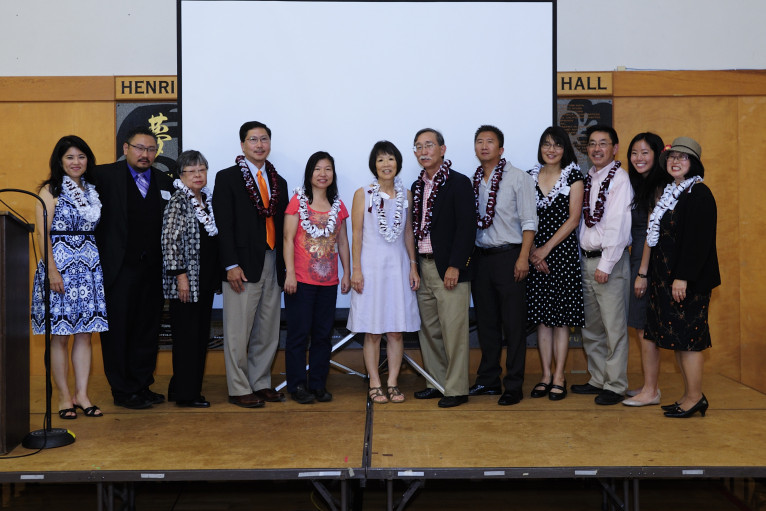By Jon Funabiki
While daily newspapers across the country battle for their lives, a scrappy little ethnic newspaper in San Francisco’s Japantown is discovering new ways to survive. It is the Nichi Bei Weekly, and it’s become my poster child for the special role that ethnic news media can play in their communities.
The elements of success include the newspaper’s deep roots in the Japanese American community, a new nonprofit business model, and an expanded mission that includes a growing set of vibrant, intergenerational cultural programs. A recent example was the Nikkei Angel Island Pilgrimage, which drew more than 600 people, young and old, to honor the 85,000 Japanese immigrants who passed through the “Ellis Island of the West.”
All of these elements were evident when the newspaper recently held its fifth anniversary celebration in a cavernous basketball gymnasium in the heart of Japantown. The program featured traditional odori dancers, a UC Berkeley a cappella choir singing songs in Japanese and English, and gourmet food with your choice of pesto mashed potatoes or steamed gohan (rice). The event had a distinctly Japanese American and multigenerational flavor, with awards and honors given to numerous volunteers and organizations who have contributed to the Nichi Bei’s success. One award went to Renaissance Journalism—more on this later.
The newspaper traces its history back to 1899, when a pioneering immigrant, Kyutaro Abiko, established the Nichi Bei Shimbun to serve San Francisco’s growing Japanese community. The newspaper was shut down during World War II, when the federal government forcibly removed Japanese Americans from the West Coast and held them in internment camps. After the war, while Japanese Americans began to rebuild their lives, former staff members and other backers restarted the newspaper in 1946 as the Nichi Bei Times. For decades following, the newspaper chronicled the community’s ups and downs.
Until September 2009. That’s when the newspaper succumbed to the nation’s economic recession and the upheaval caused by the digital revolution—two epic forces that battered virtually all newspapers, large and small, across the nation. Citing financial distress, the corporation running the Nichi Bei Times announced that it would stop the presses—forever.
Here’s the surprise twist in this storybook like plot: The reaction from the Japanese American community was swift. A group of former staff members, community leaders, other volunteers and even out-of-work journalists from the mainstream media, quickly stepped in to fill the void. Led by Kenji Taguma, editor of the English-language section of the Nichi Bei Times, the group believed that the newspaper served a vital community function and vowed to keep it running, even though they lacked funds and a business plan. Working out of borrowed offices, they managed keep publishing a successor newspaper, now called Nichi Bei Weekly, without missing a beat.
Since 2009, the level of activity has been almost manic. The group created the nonprofit Nichi Bei Foundation with a formal board of directors. If not the first, it is one of the first, ethnic newspapers to attempt a conversion to nonprofit status, which enables it to solicit grants and contributions. While continuing the print edition, the foundation has launched a website and a new digital edition, which it hopes will appeal to younger, on-the-go readers.
What is particularly striking is the Nichi Bei Foundation’s development of cultural activities. The Nikkei Angel Island Pilgrimage—cosponsored by the Angel Island Immigration Station Foundation and the National Japanese American Historical Society—was designed to help the community recognize its connection to the island’s history. Families with children, senior citizens and college students traveled by ferries from San Francisco and Tiburon to take part in the day-long activities. Another event, the Northern California Soy and Tofu Festival, has become a festive, fundraising affair attracting thousands of people to Japantown each year. Recently, the foundation added a “Films of Remembrance” and “Author Series” to its offerings.
All of these activities support the group’s desire to keep the “community connected, informed and empowered.” But nobody says it’s easy. A squad of volunteers is a vital resource, and the group continue to scramble for advertisers, contributions and grants. In 2009, Renaissance Journalism provided a grant and technical assistance to help Nichi Bei transition to the Web and to nonprofit status. Larger grants have come from the Henri and Tomoye Takahashi Foundation and others. The fifth anniversary celebration was a time to say thank you to the many individuals and organizations who have contributed to the path-breaking rebirth of this community newspaper.


